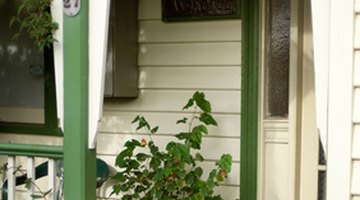Ideas to Turn an Aluminum Screened Porch Into a Room
Turning a screened porch into an enclosed room is an inexpensive way to add year-round living space to your home, primarily because the foundation work has already been done. The amount of work that the conversion will require depends in part on how high the quality of the original porch construction was. If the porch is a marginally built add-on, turning it into a permanent room will be more difficult and time consuming due to the required upgrades.
Windows

The easiest way to enclose a screened porch is simply to cover the screens with glass windows. This can be done either by re-purposing existing windows, modifying the frames so that they fit over the screens, or by the more expensive but more attractive method of having windows custom made to fit over the screens. Depending on your climate, this may only turn your porch into a three season room, since it will be insufficiently insulated to use in a northern winter.
Insulation
A more thorough conversion involves building complete walls inside the existing screen walls and insulating them. By building solid walls up to waist height and making the upper walls out of glass over screens, you can reduce the heat loss in cold weather while maintaining the open feeling and light of the porch. If you are interested in insulating the new room to the standard of the rest of the house, the screens should be entirely removed and replaced with standard insulated walls and regularly sized thermopane windows. This method will allow less light into the new room but will keep it far warmer in winter.
Roof Venting
A serious consideration is the structure of the porch roof, which after the conversion will be an addition roof. Any living space that is heated needs a roof that is both insulated and properly ventilated to keep the room warm and to avoid ice buildup on the eaves of the roof. Excessive heat escaping through the roof will cause snow on the roof to melt, and then to freeze when it reaches the gutters or the edge of the roof, which in turn will cause ice to back up under the shingles and damage them. This problem can be avoided by insulating above the ceiling, and by installing vents above the insulation at the eaves and at the peak of the roof. Proper air flow through the roof will reduce problems of condensation and melting.
References
Writer Bio
Jagg Xaxx has been writing since 1983. His primary areas of writing include surrealism, Buddhist iconography and environmental issues. Xaxx worked as a cabinetmaker for 12 years, as well as building and renovating several houses. Xaxx holds a Doctor of Philosophy in art history from the University of Manchester in the U.K.
Photo Credits
- front porch image by Steve Lovegrove from Fotolia.com
More Articles



